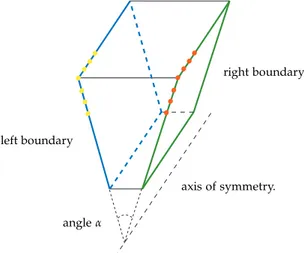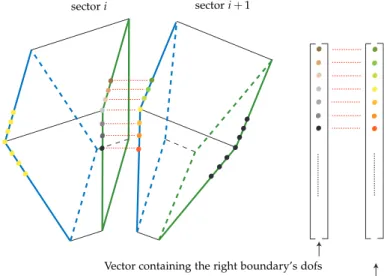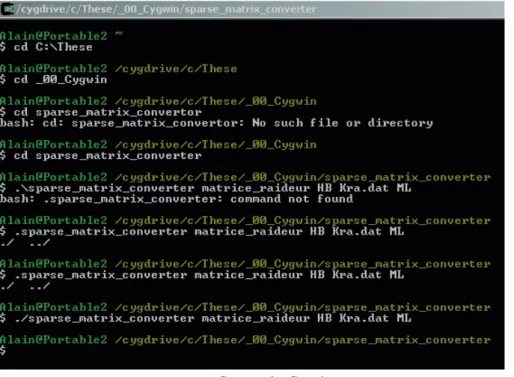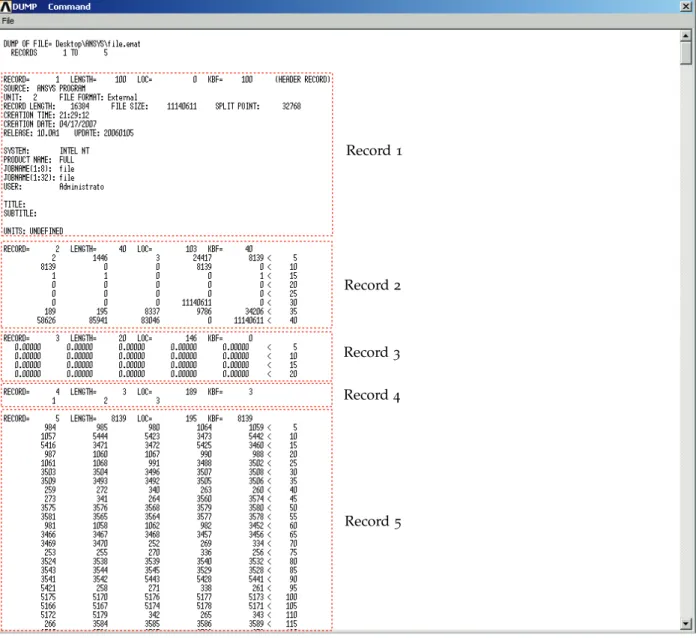HAL Id: hal-01132784
https://hal.archives-ouvertes.fr/hal-01132784
Submitted on 18 Mar 2015
HAL is a multi-disciplinary open access
archive for the deposit and dissemination of
sci-entific research documents, whether they are
pub-lished or not. The documents may come from
teaching and research institutions in France or
abroad, or from public or private research centers.
L’archive ouverte pluridisciplinaire HAL, est
destinée au dépôt et à la diffusion de documents
scientifiques de niveau recherche, publiés ou non,
émanant des établissements d’enseignement et de
recherche français ou étrangers, des laboratoires
publics ou privés.
How to extract structural matrices (mass,stiffness...)
from Ansys and import them into Matlab. Obtention of
elementary cyclic symmetric matrices from an
elementary sector in Ansys.
Alain Batailly
To cite this version:
Alain Batailly. How to extract structural matrices (mass,stiffness...) from Ansys and import them
into Matlab. Obtention of elementary cyclic symmetric matrices from an elementary sector in Ansys..
[Research Report] Université McGill. 2018. �hal-01132784�
How to extract structural matrices
(mass,stiffness. . . ) from Ansys and import them
into Matlab. Obtention of elementary cyclic
symmetric matrices from an elementary sector in
Ansys.
Alain Batailly*
Abstract
The purpose of this note is to explain how to extract stiffness and mass matrices from Ansys. This can be useful for specific calculations with other codes such as Matlab. Section one focuses on structures featuring cyclic symmetric where the stiffness and mass matrices of only one elementary sector allow to obtain the global matrices. Section two presents the Ansys commands to obtain the binary files (.emat and .full files) containing the matrices. Section three is devoted to the interpretation of these files. Keywords
Cyclic symmetry, Ansys, Matlab.
1 -Structural Dynamics and Vibration Laboratory, McGill University, 817 Sherbrooke West, McConnell Engineering Bldg, Room 122, H3A 0C3, Montr ´eal, Qu ´ebec, Canada
*Corresponding author: Tel.: +1 514 398 5321; fax: +1 514 398 7365. E-mail address:alain.batailly@mcgill.ca
Comment extraire les matrices structurelles
(masse, raideur. . . ) d’Ansys pour les importer dans
Matlab. Obtention des matrices cycliques
´el ´ementaires `a partir d’un secteur ´el ´ementaire lu
dans Ansys.
Alain Batailly*
R ´esum ´e
L’objectif de cette note technique est d’expliquer la proc´edure permettant d’extraire les matrices masse et raideur d’un mod`ele ´el´ements finis cr´e´e avec le logiciel Ansys. Cette proc´edure peut ˆetre utile lorsque des manipulations sur les matrices structurelles sont requises (par exemple sous Matlab ou Python) en dehors du cadre d´efini par Ansys. La premi`ere section porte sur les structures `a sym´etrie cyclique pour lesquelles les matrices masse et raideur du secteur ´el´ementaire permettent de reconstituer les matrices masse et raideur de la structure globale. La deuxi`eme section porte quant `a elle sur les commandes Ansys permettant d’obtenir les fichiers binaires (.emat et .full) qui contiennent ces matrices. La derni`ere section est d´edi´ee `a l’interpr´etation de ces fichiers. Mots-cl ´es
Sym´etrie cyclique, Ansys, Matlab.
1 -Laboratoire de Dynamique des Structures et Vibrations, Universit ´e McGill, 817 Sherbrooke Ouest, Pavillon McConnell, Salle 122, H3A-0C3, Montr ´eal, Qu ´ebec, Canada
Introduction
The purpose of this note is to explain how to extract stiffness and mass matrices from Ansys. This can be useful for specific calculations with other codes such as Matlab. Section one focuses on structures featuring cyclic symmetric where the stiffness and mass matrices of only one elementary sector allow to obtain the global matrices. Section two presents the Ansys commands to obtain the binary files (.emat and .full files) containing the matrices. Section three is devoted to the interpretation of these files.
1. Structures featuring cyclic symmetry
Structures featuring cyclic symmetry require to modify some parameters in Ansys before the extraction of the matrices. That is the reason why the case of these structures is given in the first chapter. The particularity of cyclic symmetry is the definition of “boundaries” allowing the expansion of the structure around the axis of symmetry.
1.1 Defining the boundaries: manual procedure
This section explains how to manually define the boundaries of cyclic symmetric structures. However, for most of the cyclic symmetric structures, Ansys will be able to automatically define these boundaries. In that case, you only need to read the second section of this chapter. Each boundary of the structure must have exactly the same number of nodes. The matrices given by Ansys correspond to a full sector and so are different from the elementary matrices required for a
angle α left boundary
right boundary
axis of symmetry.
Figure 1.General representation of cyclic symmetric structures with2πα sectors
cyclic symmetry study. A reorganization of the dofs must be done depending on their belonging to a boundary or not. In our case we consider cylindrical coordinates which actually makes the study easier because the elementary blocks will be obtained directly from the reorganization the dofs. Any other coordinates systems will require modifications of the boundary dofs so that the right boundary of sector i is compatible with the left boundary of sector i+ 1. Ansys can automatically generate the left and right boundaries. But with complex (for instance non planar) boundaries, this option might not include all the nodes. Depending on the orientation of the structure, the terms ”CYCLIC M01H” and ”CYCLIC M01L” are alternate if an error message appears when the analysis starts.
1.1.1 Right boundary
Here are the steps to follow:
¶ click on Select¿Component Manager. . . ¿Create Component · quote the line Pick entities
¸ enter the name CYCLIC M01H before validation by clicking on OK
¹ select the nodes on the left boundary (seeAand the procedure of nodes selection) º validate the selection by clicking on Apply
» a new component should appear in the Component Manage Window named CYCLIC M01H
1.1.2 Left boundary
Follow the procedure of the previous subsection exchanging CYCLIC M01H by CYCLIC M01L. The boundaries of the cyclic symmetry are now set. The other parameters of the cyclic symmetry study can be entered using the option user defined.
Figure 2.Window “Component Manager”
1.2 Defining the boundaries : automatic procedure
With most of the cyclic symmetric structures, the auto-defined option allows to obtain automatically the boundaries. If not, the first thing to do before using the manual procedure is to modify the tolerance for detecting the nodes on the boundary.
1.3 Linking the boundaries
Obtaining the list of the nodes on each boundary is quite easy with Ansys as explained in appendixA. However it is critical to check the correspondancy of the nodes obtained in each list such as shown in figure3. The list of nodes can be written in a file by Ansys sorting them among different criterias (X, Y or Z position, number of nodes...). Instead of
sector i sector i + 1
Vector containing the left boundary’s dofs Vector containing the right boundary’s dofs
Figure 3.Representation of the correspondancy of the nodes between the two boundaries
complex modifications of these lists, the use of the STATUS command in Ansys will directly give the correspondance between the two boundaries. After defining all the parameters for the cyclic symmetry, the command:
*STATUS,CYCLIC
| {z }
variable
xref n
will create the status.lis file containing the correspondance table between the nodes of the two boundaries. After deleting all the blank lines and non-numerical lines in this file, it can be saved in a status.txt file. The program status.m given in Bis the Matlab program modifying this file and creating from it two vectors: cycg and cycd respectively the nodes on the left and right boundaries (considering the correspondance table: the node at the ithline in vector cycg is facing the node at the ithline in vector cycd.
2. Obtaining the matrices from Ansys
2.1 Writing .emat and .full files
The procedure for writing .emat and .full files containing the mass and stiffness matrices (Harwell-Boeing format) has been detailed inCedric Rouault’s reportavailable in french.
First step Right before launching the analysis the following command must be entered in Ansys: EMATWRITE, YES the effect of this command is to force Ansys to create a .emat file. Then, a modal analysis must be launched if mass matrix is needed otherwise, a simple static analysis is enough for getting the stiffness matrix. The command WRFULL makes the analysis stop after writing the files meaning that Ansys won’t actually do the analysis. This command can be useful to avoid long calculations with Ansys.
Obtaining the matrices In the ”menu” bar, use file¿list¿binary files then choose matrix. Type in the window File to be read the link to the .full file that has been generated in the previous step. The format must be ascii. right hand side is not useful for getting the matrices. The only thing to do now for each matrix is to give the name wanted for each matrix created in the Ansys work directory.
Getting the node equivalence table In the menus bar : file¿list¿binary files. then choose other. Select Records to be list on All records and amt of output per record on Entire record. Type in the window file to be read the link to .emat file. The window appearing contains all the information of the analysis on the structure. The nodal equivalence table is in the Record 5. Please refer to the ’Guide to interfacing with Ansys’ for more details on the content of the .emat file.
Transferring the matrices in Matlab The matrices written by Ansys are compatible with the Harwell Boeing (HB) format. They must be converted in Matlab format. The program sparse matrix converter availablehere.
3. Converting the matrices from HB to Matlab format
3.1 The Cygwin method
As mentionned previously, this step requires a program working under Linux. The following procedure is only necessary if you work under windows environment. A Linux emulator under windows is used: Cygwin (version 3.2.15(13)-release i686-pc-cygwin). The matrices given by Ansys must be transferred in the Cygwin working folder
Figure 4.Commandes Cygwin.
”sparse matrix converter”. the required commands are detailed on the picture4. The result is a dat file containing a three column table compatible with ”spconvert” function in Matlab.
3.2 The RBio Matlab routine
Using the Matlab RBio routine (availablehereorhere) is definitely the fastest way to deal with Harwell-Boeing (HB) or Rutherford-Boeing (RB) format matrices under Matlab. However, the conversion of the matrices from HB/RB format to Matlab format is slightly different from the one obtain in the previous subsection. Results with matrices from this routine have not been checked.
4. Description of the matrices
4.1 What Ansys gives
The three matrices which can be obtained from Ansys (stiffness, mass and damping) might have less lines and columns than the total number of dofs of the structure. This comes from the fact that Ansys provides the matrices after considering the boundary conditions. For instance, if some nodes of the structure are built in, then they won’t appear in the matrices given by Ansys. However, it is important to notice that the other tables such as the nodal equivalence table contain all the dofs. Consequently, it is not possible to directly link the matrices with this table.
4.2 Reading the .emat file
¶ Click on File¿List. . . ¿Binary files . . .1 · Choose Other¿ok
¸ In Records to be listed, choose All records. This field allows to choose the data to be plotted among all the available ones in the .emat file. Fields 1 to 5 are the ones to focus on
¹ In order to plot specific lists or data, choose Specified records then type the number of the first list to plot in the NSTRT Starting record field and the number of the last list to plot in the Nstop ending record field
º In the FORM field, choose the option entire records. Without this option, Ansys will only write the header of each list without the content
» in [FILEAUX2] Binary file to list, point at the folder containing the .emat file and click ok ¼ The file should now appears in a separate windows
Record 1
Record 2
Record 3 Record 4
Record 5
Figure 5.Description of the 5 first ”record” of the ”.emat” file.
4.3 Interpreting the .emat file
Figure5shows the Ansys window where is written the .emat file. Only the 5 first records of this file will be detailed in this section.
Record 1 This list contains general information on the .emat file such as creation time of the analysis. . .
Record 2 this list is actually a table containing data linked with the analysis. In our case, here is the meaning of some of the number appearing:
1Do not pay attention to the error message This function requires that files currently open be closed. Executing the function will exit the preprocessor that might appear
• 1446 : number of elements • 3 : number of dofs per node • 24417 : total number of dofs. . .
More details about this record can be found in the ”ANSYS Interfacing Guide” (chapter 1.6.2 page 1-29). Record 3 This list is relative to time as a parameter of a dynamic analysis.
Record 4 Only a few details are given about this record. It is mainly a code linked with the nature of the dofs for each node. In our case, (1,2,3) means three displacements in a cartesian basis.
Record 5 This list is essential for the analysis of the matrices given by Ansys The list is composed of 5 columns of numbers plus a sixth column containing indices of position. It must be seen as a classical single column vector that would be spread on 5 columns to save some space. In the case of figure5, the list represents a vector ”V” which dimensions are[8139 × 1]. This must be read as follow: node V (i, 1) (number of the node that would appear in Ansys while selected) is actually at the ithline/column of the matrices. This information is linked with the nodes, in order to have the position of the dofs we must know that node V(i, 1) is linked to the dofs 3V (i) − 2, 3V (i) − 1 and 3V (i). This dofs will be found on lines/columns 3i − 2, 3i − 1 and 3i of the full matrices (meaning that there is a shift in these numbers if some nodes are built in for instance).
5. From Ansys to Matlab: general program
This chapter briefly describes the Matlab program used to calculate the eigenfrequencies of a cyclic symmetric structure created with Ansys. The inputs of this program are:
• the mass and stiffness matrices of the structure’s elementary sector (see4), • the list of built-in nodes: encas.txt (seeA).
• the status.txt file (seeB),
• the record5 vector modified as a column vector in a ”.txt” file (seeC),
clear; clc;
% Reading status.lis file which non numerical lines have been removed % The extension of the file is now ".dat"
load status.txt; A=size(status); a=A(1,1); b=A(1,2);
% We only keep the columns giving the node numbers Cor1=status(:,3:4);
% The lines containing virtual negative values are deleted k=1; for i=1:a if (Cor1(i,2)<=0) if (floor(i/2)==i/2) Cor1(i,2)=0; Cor1(i-1,2)=0; else Cor1(i,2)=0; Cor1(i+1,2)=2; end end end
% Fitting in two columns for i=1:a/2
Cor2(i,1)=Cor1(2*i-1,2); Cor2(i,2)=Cor1(2*i,2); end
% Deleting the "0" lines for i=1:a/2
if Cor2(i,1)>0
Correspondance(k,1)=Cor2(i,1); Correspondance(k,2)=Cor2(i,2); k=k+1;
end end
% Checking
size(Correspondance)
% The "Correspondance" vector actually contains the two boundaries: % cyc_g and cyc_d
% The boundary "M01H" is the left column, the boundary "M01L" is the % right column.
cycg=Correspondance(:,2); cycd=Correspondance(:,1); save cycg.txt cycg -ascii save cycd.txt cycd -ascii
save Correspondance.txt Correspondance -ascii % Memory clear
clear;clc; %
% Creating the cyclic symmetry elementary blocks: K0, K1, M0 and M1 % load encas.txt encas_ddl=zeros(3*length(encas),1); for i=1:length(encas) encas_ddl(3*(i-1)+1,1)=3*encas(i,1)-2; encas_ddl(3*(i-1)+2,1)=3*encas(i,1)-1; encas_ddl(3*(i-1)+3,1)=3*encas(i,1); end;
% Considering built-in nodes : modifications of the numbers load record5.txt % loading Record5.txt from Ansys
col=record5; col_ddl=zeros(3*length(col),1); for i=1:length(col) col_ddl(3*(i-1)+1,1)=3*col(i,1)-2; col_ddl(3*(i-1)+2,1)=3*col(i,1)-1; col_ddl(3*(i-1)+3,1)=3*col(i,1); end; kk=1; for i=1:length(col_ddl) test=0;
% is dof "i" built in ? for j=1:length(encas_ddl)
if (col_ddl(i,1)==encas_ddl(j,1)) test=1;
end; end;
% if dof "i" is built in then here is its actual position in the % matrices given by Ansys
if (test==0) col2_ddl(kk,1)=col_ddl(i,1); kk=kk+1; end; end; % Modifying CYCD load cycd.txt
% Deleting nodes appearing twice (Ansys bug) k=1;
cycd_corrige(1,1)=cycd(1,1); for i=2:length(cycd)
testb=0;
if testb(1,1)==0 cycd_corrige(k,1)=cycd(i,1); k=k+1; end test=0; end clear cycd cycd=cycd_corrige; clear cycd_corrige cycd_ddl=zeros(3*length(cycd),1); for i=1:length(cycd) cycd_ddl(3*(i-1)+1,1)=3*cycd(i,1)-2; cycd_ddl(3*(i-1)+2,1)=3*cycd(i,1)-1; cycd_ddl(3*(i-1)+3,1)=3*cycd(i,1); end; jj=1; for i=1:length(cycd_ddl) for j=1:length(col2_ddl(:,1)) if (col2_ddl(j,1)==cycd_ddl(i,1)) cycd2_ddl(jj,1)=j; jj=jj+1; end; end; end;
% CYCD2_DDL vector contains the position of the right % boundary dofs in the matrices given by Ansys
%
% Modifying CYCG load cycg.txt
% Deleting nodes appearing twice (Ansys bug) k=1; cycg_corrige(1,1)=cycg(1,1); for i=2:length(cycg) testb=0; testb=size(find(cycg(1:i-1,1)==cycg(i,1))); if testb(1,1)==0 cycg_corrige(k,1)=cycg(i,1); k=k+1; end test=0; end clear cycg cycg=cycg_corrige; clear cycg_corrige cycg_ddl=zeros(3*length(cycg),1); for i=1:length(cycg) cycg_ddl(3*(i-1)+1,1)=3*cycg(i,1)-2; cycg_ddl(3*(i-1)+2,1)=3*cycg(i,1)-1; cycg_ddl(3*(i-1)+3,1)=3*cycg(i,1); end; jj=1; for i=1:length(cycg_ddl) for j=1:length(col2_ddl(:,1)) if (col2_ddl(j,1)==cycg_ddl(i,1)) cycg2_ddl(jj,1)=j; jj=jj+1; end;
end; end;
% CYCG2_DDL vector contains the position of the left % boundary dofs in the matrices given by Ansys %
% Creating the inversion matrix (reorganizing lines and columns) k1=0; u=1; compteur=0; clear vect_int vect_int=zeros(length(col2_ddl)-length(cycd2_ddl)-length(cycg2_ddl),1); kk=1; for i=1:length(col2_ddl) test=0; for j=1:length(cycg2_ddl) if (cycg2_ddl(j,1)==i) test=1; end; if (cycd2_ddl(j,1)==i) test=1; end; end; if (test==0) vect_int(kk,1)=i; kk=kk+1; end; end;
% VECT_INT contains the position of all the dofs being "internal" % (neithe boundary conditions neither cyclic boundaries)
temp=zeros(length(col2_ddl),3); for i=1:length(cycg2_ddl) temp(i,1)=i; temp(i,2)=cycg2_ddl(i,1); temp(i,3)=1; end; for i=length(cycg2_ddl)+1:length(col2_ddl)-length(cycd2_ddl) temp(i,1)=i; temp(i,2)=vect_int(i-length(cycg2_ddl),1); temp(i,3)=1; end; for i=length(col2_ddl)-length(cycd2_ddl)+1:length(col2_ddl) temp(i,1)=i; temp(i,2)=cycd2_ddl(i-length(col2_ddl)+length(cycd2_ddl),1); temp(i,3)=1; end;
% Reorganizing mass and stiffness matrices L=spconvert(temp);
% Kra.dat and Mra.dat are stiffness and mass matrices given by Ansys % after conversion from HB format to Matlab format.
load Kra.dat load Mra.dat K=spconvert(Kra); M=spconvert(Mra); Kreo=L*K*L’; Mreo=L*M*L’;
% Defining the blocks
Mgg=Mreo(1:length(cycg2_ddl),1:length(cycg2_ddl));
Mgi=Mreo(1:length(cycg2_ddl),length(cycg2_ddl)+1:length(cycg2_ddl)+... length(vect_int));
Mgd=Mreo(1:length(cycg2_ddl),length(cycg2_ddl)+length(vect_int)+1:end); Mii=Mreo(length(cycg2_ddl)+1:length(cycg2_ddl)+length(vect_int),...
length(cycg2_ddl)+1:length(cycg2_ddl)+length(vect_int)); Mid=Mreo(length(cycg2_ddl)+1:length(cycg2_ddl)+length(vect_int),... length(cycg2_ddl)+length(vect_int)+1:end); Mdd=Mreo(length(cycg2_ddl)+length(vect_int)+1:end,length(cycg2_ddl)+... length(vect_int)+1:end); Kgg=Kreo(1:length(cycg2_ddl),1:length(cycg2_ddl)); Kgi=Kreo(1:length(cycg2_ddl),length(cycg2_ddl)+1:length(cycg2_ddl)+... length(vect_int)); Kgd=Kreo(1:length(cycg2_ddl),length(cycg2_ddl)+length(vect_int)+1:end); Kii=Kreo(length(cycg2_ddl)+1:length(cycg2_ddl)+length(vect_int),... length(cycg2_ddl)+1:length(cycg2_ddl)+length(vect_int)); Kid=Kreo(length(cycg2_ddl)+1:length(cycg2_ddl)+length(vect_int),... length(cycg2_ddl)+length(vect_int)+1:end); Kdd=Kreo(length(cycg2_ddl)+length(vect_int)+1:end,length(cycg2_ddl)+... length(vect_int)+1:end);
% Defining elementary cyclic symmetry blocks
LL=speye(length(col2_ddl)-2*length(cycg2_ddl),length(col2_ddl)-2*... length(cycg2_ddl)); for i=1:length(col2_ddl)-2*length(cycg2_ddl) LL(i,i)=0; end; a=size(Mid); MAT_O=zeros(length(cycg2_ddl),a(1,2)); M0=[Mgg+Mdd Mgi; Mgi’ Mii];
M1=[Mgd MAT_O;Mid LL]; K0=[Kgg+Kdd Kgi; Kgi’ Kii]; K1=[Kgd MAT_O;Kid LL]; save BLOCS K0 M0 K1 M1
% Harmonic blocks and calculation of the eigenfrequencies K_0=K0+(K1+K1’);
M_0=M0+(M1+M1’);
clear LL Kdd Kid Kii Kgd Kgg Kreo Mreo Mgg Mgi Mgd Mii Mid Mdd K M temp [Z,W]=eigs(K_0,M_0,10,’sm’); F=sqrt(diag(W))/2/pi; clear K_0 M_0 clear K0 M0 K1 M1 nd=0; file=[’Blocs_harmonique_’,num2str(nd)] save (file,’F’,’Z’,’W’) nd for nd=1:27 nd load BLOCS K=[K0+(K1+K1’)*cos(nd*2*pi/56) (K1-K1’)*sin(nd*2*pi/56); ... (K1’-K1)*sin(nd*2*pi/56) K0+(K1+K1’)*cos(nd*2*pi/56)]; M=[M0+(M1+M1’)*cos(nd*2*pi/56) (M1-M1’)*sin(nd*2*pi/56); ... (M1’-M1)*sin(nd*2*pi/56) M0+(M1+M1’)*cos(nd*2*pi/56)]; clear K0 K1 M0 M1 [Z,W]=eigs(K,M,10,’sm’); F=sqrt(diag(W))/2/pi; clear K M
file=[’Blocs_harmonique_’,num2str(nd)] save (file,’F’,’Z’,’W’) clear F end load BLOCS K_0=K0-(K1+K1’); M_0=M0-(M1+M1’); clear K0 K1 M0 M1 [Z,W]=eigs(K_0,M_0,10,’sm’); F=sqrt(diag(W))/2/pi; clear K_0 M_0 nd=28; nd file=[’Blocs_harmonique_’,num2str(nd)] save (file,’F’,’Z’,’W’)
A. Nodes selection procedure
This procedure describes how to obtain a file containing a list of nodes picked manually using Ansys interface. This can also be useful to get any kind of list such as built-in nodes or nodes on a boundary. On the main Ansys window, follow these steps:
¶ Click on Select¿Entities. . .
· Check that the following options are selected : Nodes, By Num/Pick and From Full and Click on ok ¸ Pick with the cursor (one by one or a group using the box option) the nodes you need
¹ Click on Apply and Click on ok º Click on List¿Nodes. . .
» Choose your organization options and click on ok: the list of the selected nodes appear in an Ansys window ¼ Save it with the following extension: .lis. In order to use these files with Matlab they must be modified by deleting
all the non numerical lines.
B. status.m program
clear; clc;
% Reading status.lis file which non numerical lines have been removed % The extension of the file is now ".txt"
load status.txt; A=size(status); a=A(1,1); b=A(1,2);
% We only keep the columns giving the node numbers Cor1=status(:,3:4);
% The lines containing virtual negative values are cancelled k=1; for i=1:a if (Cor1(i,2)<=0) if (floor(i/2)==i/2) Cor1(i,2)=0; Cor1(i-1,2)=0; else
Cor1(i,2)=0; Cor1(i+1,2)=2; end
end end
% Fitting in two columns for i=1:a/2
Cor2(i,1)=Cor1(2*i-1,2); Cor2(i,2)=Cor1(2*i,2); end
% Deleting the "0" lines for i=1:a/2 if Cor2(i,1)>0 Correspondance(k,1)=Cor2(i,1); Correspondance(k,2)=Cor2(i,2); k=k+1; end end % Checking size(Correspondance)
% The "Correspondance" vector actually contains the two boundaries: % cyc_g and cyc_d
% The boundary "M01H" is the left column, the boundary "M01L" is the % right column.
cycg=Correspondance(:,2); cycd=Correspondance(:,1); save cycg.txt cycg -ascii save cycd.txt cycd -ascii
save Correspondance.txt Correspondance -ascii % Memory clear
clear;clc;
C. record5.m program
The following code is a very shot program to reorganize the record5.txt file obtained from Ansys. clear; clc;
% This program requires the file to be cleared (last two columns filled % with ’<’ and line numbers must be erased). "0" must be added if the last % line contains less than 5 numbers.
load record_5.txt a=length(record_5);
b=length(find(record_5(a,:)>0)); L=5*(a-1)+b; record_modify=zeros(L,1); for i=1:5 for j=1:a k=(j-1)*5+i; if k>L
save record_modify.txt record_modify -ascii break; end record_modify(k,1)=record_5(j,i); end end length(record_modify) nnz(record_5) nnz(record_modify)



